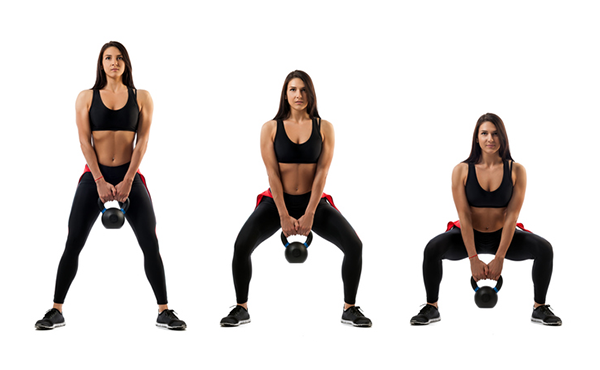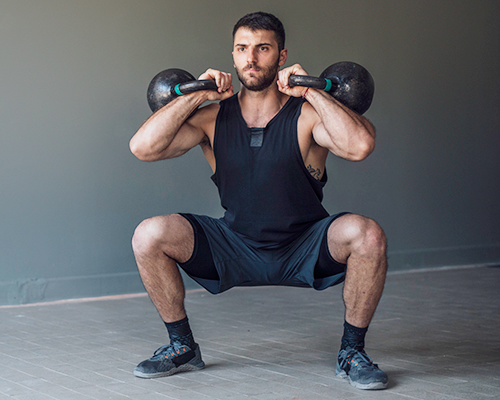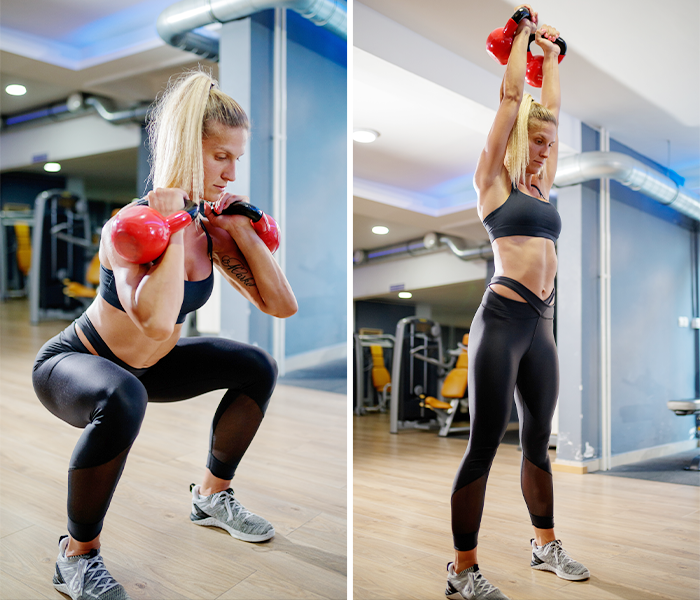What’s the best way to spice up a standard squats? Add a kettlebell (or two) and make them kettlebell squats!
Even if you’ve experimented with adding resistance to your squats before, the kettlebell squat provides an entirely different experience, thanks to its unique shape.
“The kettlebell offers a wide variety of options for holding and placement when squatting,” says Jordan Duncan, DC, owner of Silverdale Sport & Spine in Silverdale, Washington. “You can hold a kettlebell by the bell (the round part of the kettlebell), the handle (the horizontal section), or the horns (the straight or slightly curved parts that connect the handle to the bell).”
According to Duncan, switching up your grip, the positioning of the kettlebell, or its proximity to your body can change which muscles are engaged during the kettlebell squat.
(The same principle applies to other kettlebell movements.)
With seemingly endless kettlebell squat variations, you’ll never get bored, and you’re bound to get a well-rounded workout.
New to the kettlebell squat? “Begin with a light kettlebell and make sure you have mastered the squat technique before progressing to more challenging weights,” Duncan says.
He recommends starting with the kettlebell goblet squat (see below).
Also, be mindful of your breathing. “Breathing is very important in the kettlebell squat, as is the timing of the breath. You want to perform one breath per squat, inhaling on the way down and exhaling on the way up,” Duncan says.
Here are just a few ways to do kettlebell squats.
1. Kettlebell Goblet Squat
“The kettlebell goblet squat is a simple, effective way to develop the fundamental squatting movement pattern,” Duncan says. “Holding the bell in front of the body helps to increase the range of the squat motion and improve balance while squatting.”
- Stand with your feet shoulder-width apart, and your toes pointed forward.
- With bent elbows, hold a kettlebell in front of your chest. Keep your elbows close to your body and avoid flaring them out. You can hold the kettlebell by the handle or the horns. Or, hold the kettlebell upside-down by the bell.
- Keeping your back flat and core braced, bend your knees, push your hips back, and lower your body until your thighs are parallel to the floor. As you squat down, your elbows should move past your inner thighs.
- Pause, and then push yourself back up to the starting position.
2. Kettlebell Sumo Squat
“While the sumo squat trains similar muscles as the traditional squat, its wide stance and foot position also emphasize the hip adductor muscles of the inner thighs,” Duncan says.
- Stand with your feet wider than shoulder-width apart and your toes turned out about 45 degrees.
- With your arms straight down in front of you, use both hands to grip the handle of a kettlebell.
- Keeping your back flat and core braced, bend your knees, push your hips back, and lower your body until your thighs are parallel to the floor. As you squat down, the kettlebell will hang between your legs. Brace your core to make sure that the weight does not pull your chest forward.
- Pause, and then push yourself back up to the starting position.
3. Double Front-Racked Kettlebell Squat
“Similar to the kettlebell goblet squat, holding the kettlebell in front of the body helps to increase the squat range of motion,” Duncan says. “The core muscles are also challenged to stabilize the body with the kettlebells held in this position.”
- Stand with your feet shoulder-width apart, and your toes pointed forward.
- With each hand, hold a kettlebell in the racked position. (Hold the kettlebell by the handle in front of your shoulders so that the bell is resting on the outside of the forearm and the elbow is tucked in close to the torso.) Alternatively, you can hold just one kettlebell for a single-arm kettlebell squat variation.
- Keeping your back flat and core braced, bend your knees, push your hips back, and lower your body until your thighs are parallel to the floor.
- Pause, and then push yourself back up to the starting position.
4. Kettlebell Squat to Overhead Press
“This exercise trains the transfer of force from the lower body to the upper body, which requires optimal core activation and timing,” Duncan says.
- Stand with your feet shoulder-width apart, and your toes pointed forward.
- With each hand, hold a kettlebell in the front-racked position. Alternatively, you can hold just one kettlebell for a single-arm kettlebell squat to overhead press variation.
- Keeping your back flat and core braced, bend your knees, push your hips back, and lower your body until your thighs are parallel to the floor.
- Pause, and then, as you return to a standing position, push both kettlebells straight up overhead in one fluid motion, locking your elbows and bringing your bicep close to your ears.
- As you move into your next squat, lower the kettlebells to a racked position.
The post The Leg Exercise You’re Missing in Your Routine: How to Do Kettlebell Squats appeared first on The Beachbody Blog.





0 Comments